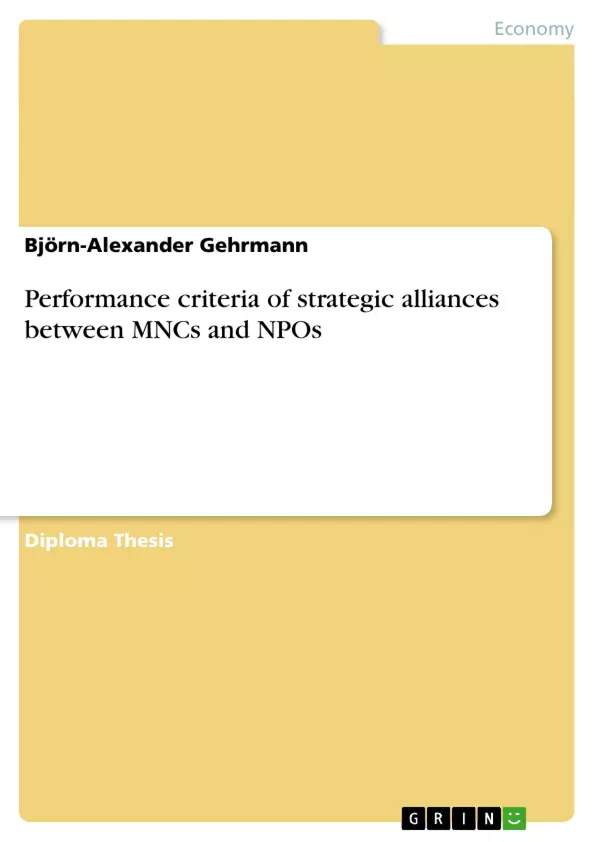Strategische Allianzen zählen zu den wichtigsten Gebieten der Organisationsforschung sowie des Strategischen Managements. Untersuchungen konzentrieten sich bisher auf Partnerschaften von Unternehmen. In den letzten Jahren stieg die Anzahl von Kooperationen zwischen Firmen und Non-Profit-Organisationen (NPO) wie Vereinen oder Sozialen Gruppen. Unilever, GlaxoSmithKline oder Microsoft zählen zu den Unternehmen, die mit NPOs (auch NGOs) wie dem World Wildlife Fund for Nature, Medicines for Malaria Venture oder Greenpeace zusammenarbeiten. Besonders in den Bereichen der AIDS/HIV-Bekämpfung, dem Umweltschutz oder der Agrarwirtschaft arbeiten Firmen vermehrt mit NPOs zusammen. Problematisch ist bis heute, wie der Erfolg oder Misserfolg derartiger Allianzen zu fassen ist, da sowohl ökonomische als auch soziale Ziele in die Messung einfließen müssen.
Björn Gehrmann untersuchte und entwickelte erstmals, welche Kriterien Erfolge von Partnerschaften zwischen Multinationalen Unternehmen (MNCs) und NPOs sichtbar machen können. Mit Hilfe einer Balanced Scorecard strukturiert der Autor die Erfolgskriterien und liefert Unternehmen sowie Organisationen aus dem sozialen Sektor ein Werkzeug, gemeinsame Projekte in den Bereichen Corporate Social Responsibility, Corporate Citizenship oder Nachhaltigkeit zu messen. Diverse Beispiele aus der Praxis verdeutlichen und unterstreichen die Ergebnisse. Das Werk wurde vom Lehrstuhl für Organisation und Unternehmensführung der Universität Paderborn mit der Bestnote ausgezeichnet und basiert auf den Top-Journals der deutschen sowie amerikanischen Management und Strategie Forschung.
Inhaltsverzeichnis (Table of Contents)
- Introduction.
- Forging Strategic Alliances across Sector Frontiers.......
- The Framework of Alliances between MNCs and NPOs within the Social Context of Organizations
- Introducing the NPO as potential Alliance Partner for MNCs in Cross-sector Alliances
- Development of a Working Definition for Cross-sector Alliances between MNCs and NPOS
- Motives of MNCs and NPOs to engage in Cross-sector Alliances
- Developing Performance Criteria from a bilateral Theoretical Perspective..
- Literature Review on Alliance Performance...
- Theoretical Approaches of Alliance Performance.
- The Resource-based View as Theoretical Foundation..
- Historical Development
- Main Assumptions and Conceptual Framework.
- Performance Criteria in Cross-sector Alliances derived from the Resource-based View.
- The New Institutionalism as Theoretical Foundation.
- Historical Development
- Main Assumptions and Conceptual Framework.
- Performance Criteria in Cross-sector Alliances derived from the New Institutionalism
- Combining Performance Criteria derived from the Resource-based View and New Institutionalism..
- Structuring Performance Criteria in Cross-sector Alliances.
- The Balanced Scorecard as Tool to assess Performance in an Environment of multiple Interest
- Modifying the Balanced Scorecard to measure Cross-sector Alliance Performance
- Performance Conflicts emerging from Combination of Resource-based View and New Institutionalism
- Concluding Remarks
- Summary
- Limitations and Implications....
Zielsetzung und Themenschwerpunkte (Objectives and Key Themes)
This diploma thesis examines the performance criteria of strategic alliances between multinational companies (MNCs) and non-profit organizations (NPOs). The main objective is to develop a comprehensive framework for measuring the success of these cross-sector collaborations, taking into account both the resource-based view and the new institutionalism as theoretical perspectives. This framework will provide a comprehensive understanding of the key factors driving performance in these unique partnerships.
- The role of strategic alliances in bridging the gap between the for-profit and non-profit sectors
- The distinct motives and objectives of MNCs and NPOs in engaging in cross-sector alliances
- The development of a working definition for cross-sector alliances between MNCs and NPOs
- The application of the resource-based view and the new institutionalism to develop performance criteria for these alliances
- The implementation of a modified balanced scorecard to assess the performance of cross-sector alliances
Zusammenfassung der Kapitel (Chapter Summaries)
The initial chapters introduce the concept of cross-sector alliances between MNCs and NPOs, outlining the theoretical frameworks underpinning these partnerships. This includes exploring the motivations of both parties, the development of a working definition, and a comprehensive literature review on alliance performance. Chapters 3 and 4 delve into the resource-based view and the new institutionalism, analyzing how these perspectives contribute to the development of performance criteria for cross-sector alliances. Chapter 3 analyzes the theoretical perspectives and explores the specific performance criteria derived from each approach. Chapter 4 focuses on structuring these criteria within the framework of a modified balanced scorecard, designed to accommodate the specific challenges of measuring performance in cross-sector alliances.
Schlüsselwörter (Keywords)
This diploma thesis revolves around the key concepts of strategic alliances, cross-sector collaborations, MNCs, NPOs, performance criteria, resource-based view, new institutionalism, and balanced scorecard. The research focuses on the unique challenges and opportunities presented by partnerships between for-profit and non-profit organizations, exploring the development of a comprehensive framework for measuring their success.
- Quote paper
- Diplomkaufmann Björn-Alexander Gehrmann (Author), 2005, Performance criteria of strategic alliances between MNCs and NPOs, Munich, GRIN Verlag, https://www.grin.com/document/64334



